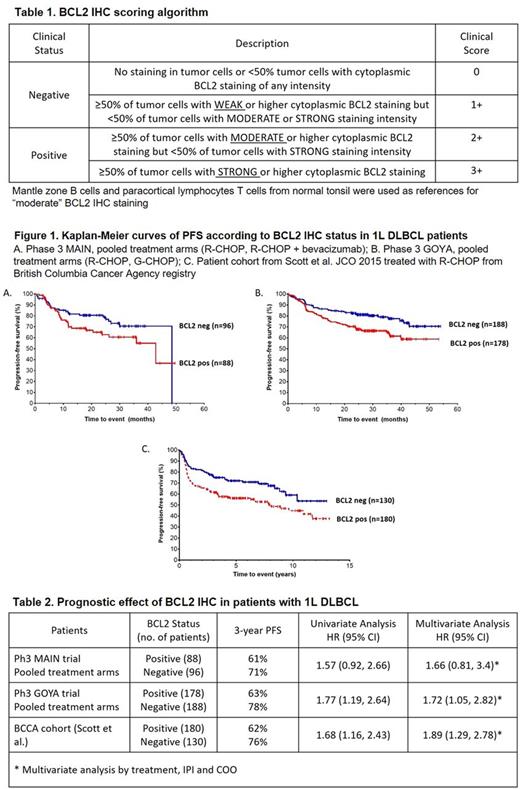Abstract

Introduction.High BCL2 protein expression has been associated with inferior outcome in multiple studies in diffuse large B-cell lymphoma (DLBCL) (Gascoyne et al. 1997; Salles et al. 2011; Horn et al. 2013; Tsuyama et al. 2017). Patients with high levels of BCL2 expression may benefit from treatment with venetoclax, a first-in-class, highly selective BCL2 inhibitor with demonstrated activity in cell lines and xenograft models (Souers et al. 2013, Punnoose et al. 2016). The evaluation of BCL2 as a prognostic marker has been complicated by the variability in recognized immunohistochemistry (IHC) thresholds (de Jong et al. 2007; Tsuyama et al. 2017) and the impact of cell-of-origin (COO) (Iqbal et al. 2011). Using a BCL2 IHC scoring algorithm that was developed to identify cell lines that are sensitive to BCL2 inhibition, and that could potentially identify patients likely to benefit from venetoclax, we evaluated the prognostic capability of BCL2 IHC in three independent cohorts of 1L DLBCL patients. Cohorts included two Phase 3 studies (MAIN [NCT00486759] and GOYA [NCT01287741]), and a representative cohort from the British Columbia Cancer Agency (BCCA) registry-based population, in which subjects received chemoimmunotherapy (either rituximab or obinutuzumab, combined with cyclophosphamide, doxorubicin, vincristine and prednisone [CHOP]).
Patients and Methods. Pretreatment tumor samples were tested for BCL2 IHC using an algorithm that assesses both the percent of tumor cells stained and the intensity of staining, similar to the BCL2 algorithm proposed by Tsuyama et al. (Table 1).Whole-tissue slides from184 patients from MAIN were tested at Genentech , whole tissue slides from 366 patients from GOYA were tested at Hematogenex (Ventana assay) and tissue microarray slides from 310 patients from BCCA were tested at Ventana (Ventana assay). The NanoString Lymphoma Subtyping gene expression assay was used for classification of COO into germinal center B-cell (GCB), activated B-cell (ABC) or unclassified subtypes in MAIN (n=159), GOYA (n=353) and BCCA (n=302). Multivariate Cox regression analysis of progression-free survival (PFS) was performed in each study with the International Prognostic Index (IPI; The International NHL Prognostic Factors Project 1993) and/or COO as covariates. Given the similar treatment effect, patient data from both treatment arms in each study were merged for this analysis.
Results. Baseline characteristics were similar for the BCL2 IHC evaluable and intent-to-treat (ITT) populations of these three cohorts. Prevalence of BCL2 positive patients was 48% in MAIN, 49% in GOYA and 58% in the BCCA cohort. The prevalence of BCL2 positive samples within the ABC subtype was 64%, 75% and 60% in the MAIN, GOYA and BCCA cohorts, respectively, and 40%, 38% and 56% within the GCB subtype, respectively. In univariate analysis, BCL2 positivity was associated with shorter PFS in all three cohorts (Figure 1, A-C). In the MAIN study, the prognostic effect of BCL2 appeared to be in the GCB subgroup, not ABC, as previously reported (Punnoose et al. ASH 2015). In the two largest studies of GOYA and BCCA cohorts, the prognostic effect of BCL2 was similar in ABC and GCB (not shown), and was independent of IPI (Table 2).
Conclusions. Using a newly developed BCL2 IHC scoring algorithm, we demonstrate that DLBCL patients positive for BCL2 have a consistently inferior prognosis compared with patients negative for BCL2. The prognostic value of BCL2 IHC is independent of IPI and COO in GOYA and BCCA. The Ventana assay is currently being used in a Phase 2 study of venetoclax in combination with R-CHOP to evaluate the correlation (if any) of BCL2 expression with venetoclax + R-CHOP treatment (CAVALLI - NCT02055820).
Szafer-Glusman: Genentech: Employment. Peale: Genentech / Roche: Employment, Equity Ownership. Lei: Roche: Employment. Ray: Genentech/Roche: Employment. Farazi: Genentech: Employment. Kornacker: Roche: Equity Ownership; F. Hoffmann-La Roche: Employment. Oestergaard: F. Hoffmann-La Roche Ltd: Employment. Liu: F. Hoffmann-La Roche: Employment. Punnoose: Genentech: Employment.
Author notes
Asterisk with author names denotes non-ASH members.

This icon denotes a clinically relevant abstract


This feature is available to Subscribers Only
Sign In or Create an Account Close Modal